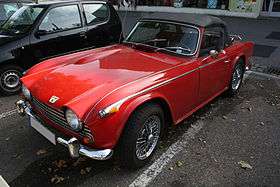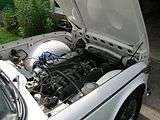Triumph TR5
The Triumph TR5 is a sports car built by the Triumph Motor Company in Coventry, England, between August 1967 and September 1968.[1]
| Triumph TR5 Triumph TR250 | |
|---|---|
 | |
| Overview | |
| Manufacturer | Triumph Motor Company |
| Production | 1967–1968 |
| Assembly | Coventry, England |
| Designer | Giovanni Michelotti |
| Body and chassis | |
| Class | Sports car |
| Body style | Roadster |
| Layout | Front-engine, rear-wheel-drive |
| Powertrain | |
| Engine | 2.5-litre straight-6 |
| Transmission | 4-speed manual, optional overdrive |
| Dimensions | |
| Wheelbase | 2,240 mm (88 in) |
| Length | 3,902 mm (154 in) |
| Width | 1,470 mm (58 in) |
| Height | 1,170 mm (46 in) |
| Kerb weight | 1,030 kg (2,271 lb) |
| Chronology | |
| Predecessor | Triumph TR4A |
| Successor | Triumph TR6 |
Visually similar to the TR4 (also styled by Michelotti),[2] the TR5 roadster sported Triumph's much more powerful 2.5-litre straight-6, fitted with Lucas mechanical fuel-injection and producing 150 bhp (110 kW). Price pressures and tighter emissions standards in the U.S. resulted in a much less powerful carburetted version, the TR250, being sold on the North American market.
At the time, fuel injection was uncommon in road cars. Triumph claimed in their sales brochure that it was the "First British production sports car with petrol injection".[3][4]
TR5
Standard equipment included front disc brakes, independent rear suspension, rack and pinion steering and a four speed gearbox. Optional extras included overdrive and wire wheels. In 1968 the basic price of the TR5 in the UK was £1,260 including taxes, with wire wheels being another £38, overdrive £60 and a tonneau cover another £13.[4]
The TR5 was available with the "Surrey Top" hard top, a weather protection system with rigid rear section including the rear window and removable fabric section over the driver and passenger's heads.
A curious feature of the TR5/Lucas petrol injection system was the very frequent occurrence of an intermittent power failure when the fuel tank was no more than a quarter full. In order to provide fresh fuel at the distributor, free from overheating/soak, unused fuel was returned to the tank where it entered very close to the high pressure fuel pump. When the fuel level fell below critical (about 3 gallons), sloshing would cause the pump to pick up a slightly aerated mixture which was sent to the fuel distributor. Unused fuel (still aerated) then passed back to the tank and was discharged close to the pump, a proportion of it being picked up and recycled to the distributor. As this cycle was repeated, gradually the volume of air in the pumped fuel reached a level where it began to affect the running of the engine. Adding as little as one gallon to the tank seemed to cure the problem. The similarly engineered contemporary saloon overcame this problem with a petrol tank specially designed for the fuel injected model. This incorporated an anti-slosh cup to ensure that the fuel outlet remained covered with fuel when the tank level was low.
Specifications
Taken from the UK sales brochure.[3]
- Engine: 2498 cc, 6 cylinder, 74.7 mm bore, 95 mm stroke, 9.5:1 compression ratio, 150 bhp (110 kW)
- Turning circle: 10.1 m (33.1 ft)
- Ground clearance: 152 mm (6.0 in)
- Luggage capacity:
- Max width: 1,180 mm (46.5 in)
- Max height: 510 mm (20.1 in)
- Capacities:
- Fuel tank: 51 litres (11.22 imp gal; 13.47 US gal)
- Engine sump: 4.53 litres (1.00 imp gal; 1.20 US gal)
- Gearbox: 1.13 litres (0.25 imp gal; 0.30 US gal)
- Acceleration in top:
- 30 to 50 mph: 7 s
- 40 to 60 mph: 7 s
- 60 to 80 mph: 8 s
- Standing 0.25 miles (0.40 km) : 16.5 s
- Gear ratios:
| Top | 3rd | 2nd | 1st | Rev. | |
|---|---|---|---|---|---|
| Ratios | 1.0 | 1.33 | 2.01 | 3.14 | 3.22 |
| Overall | 3.45 | 4.59 | 6.94 | 10.83 | 11.11 |
- Available colours:[1]
| Paint | Trim |
|---|---|
| New White | Black / Matador Red |
| Triumph Racing Green | Black, Light Tan |
| Signal Red | Black |
| Jasmine Yellow | Black / Light Tan |
| Royal Blue | Black / Shadow Blue |
| Valencia Blue | Black / Light Tan |
Performance
The fuel-injected engine could propel the TR5 from 0–50 mph (80 km/h) in 6.5 seconds, reaching a top speed of 125 mph (201 km/h).[3] Road tests at the time reported slightly different performance figures:[5]
| Sports Car World October 1968 |
Cars & Car Conversions September 1968 |
Motor 4 May 1968 | |
|---|---|---|---|
| 0-50 mph (80 km/h) | 6.2 s | 6.4 s | 6.3 s |
| Top Speed | 118 mph (190 km/h) | 112 mph (180 km/h) | 117 mph (188 km/h) |
The TR5 engine was carried forward to the TR6.
Production
The TR5 was produced in small numbers when compared with the later TR6, with just 2,947 units produced; the first car was assembled on 29 August 1967 and the last on 19 September 1968. Of these, 1,161 were destined for the UK market,[6] the remainder were left hand drive and were exported to France, Belgium and Germany amongst other countries. In the first quarter of 2011 there were approximately 410 licensed and 74 SORN TR5s registered with the DVLA.[7][8]
TR250
The Triumph TR250 was built during the same period for the North American market. Price pressures and tighter emission regulations resulted in twin Zenith-Stromberg carburettors being fitted instead of the TR5's Lucas fuel injection system. Otherwise it is nearly identical.
The TR250's engine delivered 111 bhp (81 kW), 39 bhp less than the TR5; 0–60 mph (0–97 km/h) acceleration took 10.6 seconds.[2][9] The TR250 was also available with the Surrey Top system.
In 1968, the TR250 sold in North America for approximately $3,395, with wire wheels a $118 option, overdrive $175, and air conditioning $395.[10]
Specifications
Engine:
- 2,498 cc, inline-six cylinder, 74.7 mm (2.9 in) bore, 95 mm (3.7 in) stroke, 8.5:1 compression ratio, 111 bhp (83 kW; 113 PS) at 4,500 rpm
Turning circle: 10.1 m (33 ft)
Capacities:
- Fuel tank: 51 litres (11.22 imp gal; 13.47 US gal)
- Engine sump: 5.4 L (9.64 imp pt)
- Gearbox: 1.13 L (2 imp pt)
Performance:
- 0 to 60 mph (97 km/h): 10.6 seconds[11]
- 0 to 100 mph (160 km/h): 39 seconds
- Fuel consumption: 23.5 miles per US gallon (10.0 L/100 km; 28.2 mpg‑imp) [11]
Gallery
| Wikimedia Commons has media related to Triumph TR5. |
- Triumph TR5
 1968 TR5 front quarter view
1968 TR5 front quarter view 1968 TR5 interior
1968 TR5 interior 1968 TR5 engine bay
1968 TR5 engine bay 1968 TR5 rear quarter view
1968 TR5 rear quarter view TR5 with hardtop fitted
TR5 with hardtop fitted- TR250
 TR250 Surrey Top
TR250 Surrey Top
References
- Piggott, Bill. Original Triumph TR. ISBN 1-870979-24-9.
- TR for Triumph, Chris Harvey, ISBN 0-902280-94-5
- Original UK sales brochure, 387/168/UK
- "Motor Magazine". Vol. 133 no. 3437. 4 May 1968. Cite magazine requires
|magazine=(help) - Clarke, R. M. Triumph TR4, TR5, TR250. ISBN 0-948207-53-1.
- Richards, Michael. Triumph TR4, 5, 6. ISBN 0-85429-816-9.
- "Triumph Tr5". How Many Left. Retrieved 27 June 2011.
- "Vehicle licensing statistics". Department of Transport. Archived from the original on 29 August 2011. Retrieved 27 June 2011.
- "Road & Track". December 1967. Cite magazine requires
|magazine=(help) - Motor Trend Magazine, April 1968
- Bryant, Thomas L. (June 1977), "Driving Impressions: TR3A & TR250", Road & Track
- Original Triumph TR, Bill Piggott, ISBN 1-870979-24-9